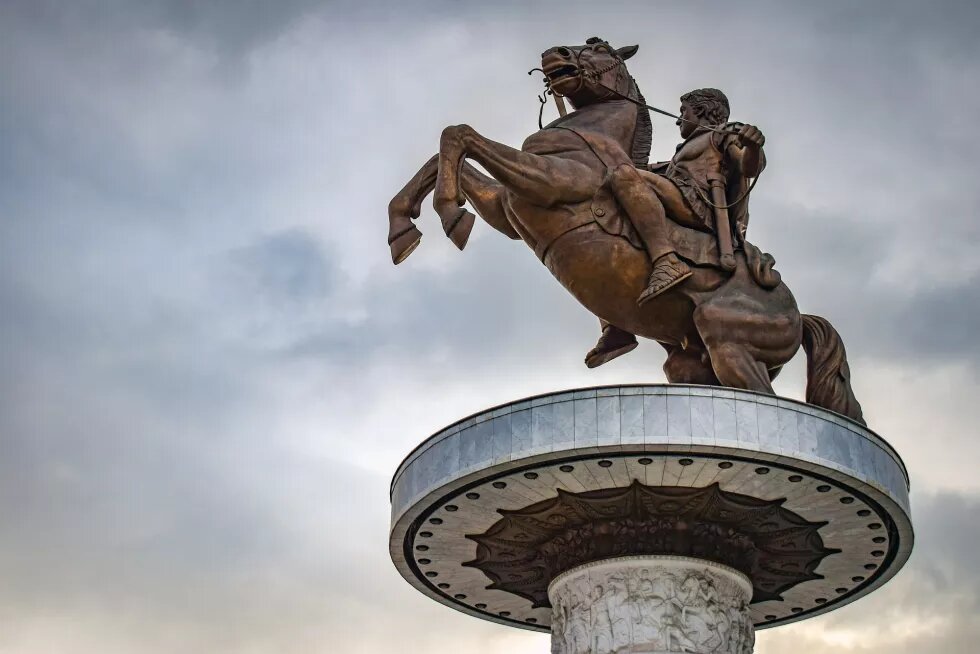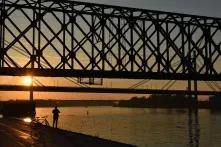
The most prominent feature of megalomaniac project "Skopje 2014" is its symbolic side. This astonishingly unusual project attracted the attention of the domestic and global public with its symbolic charge. Sculptures and monuments have been "pinned" over a couple of thousand square meters in the very centre of the capital of Macedonia over a decade, as in a voodoo ritual whose intention is to establish the Macedonian national identity. There was no space left for trees or lawns, or (almost) for walking through the labyrinth of pedestals and bronze and marble monuments set on them. Add a dozen new buildings and twenty buildings whose facades are decorated with some neoclassical or quasi-baroque ornaments, and it becomes difficult to take a walk through the city centre. Horsemen, imaginary men in coats or overcoats, tortured combatants appear from all sides and in the middle, on a huge pillar in the fountain with lions and soldiers with long spears, with a drawn sword on a saddled horse - the unnamed Alexander the Great.
Much more could be said about this project, but a lot has already been said in the public and all world media. The tone of ridiculing and astonishment about this world capital of kitsch, as they called Skopje, prevailed. That is why I would no longer waste my time with the description of this unbelievable project, which costs close to seven hundred million euros from the budget of the citizens of one of the poorest countries in Europe. What I would like to draw your attention to is something else. Money is not so important, nor is terrible aesthetics - if this architecturally and sculpturally miserably executed monster is measurable by aesthetic parameters at all. The most important thing is that the grandeur of this symbolic and looting project has managed to cast a shadow on the seizure of the public space in other parts of the city, where the concrete monstrosities of residential and commercial buildings have emerged. Much earlier, this was categorised as the accumulation of capital through the misappropriation of public space, by one of the most important contemporary intellectuals dealing with urban issues, David Harvey.
With the end of the "Skopje 2014" project, not only the Macedonian nationalist hungry spirit was fed. Its counterpart, Albanian nationalism, got its part of the city to ill-treat, so the neighbouring Skanderbeg Square was turned into a nationalist showcase for another actor of the Macedonian ethnocratic elite. Thus, to the great satisfaction of the political elites in Macedonia, the capital city is symbolically divided and demarcated. Through the policy of ethnonationalism, the citizens of Macedonia lost their political subjectivity as citizens and in return, they gained an ethnic determinant that they cannot liberate themselves from in the political life. The ethnocratic elite took over the rule over Macedonia, safely enthroned and able to control all social resources. In this way, the republic as res public was killed, as a public good, and space was created for the capitalist rule and for the private good with no alternative.
A neoliberal robbery of the public space happened to Skopje. While everyone talks about the state expropriation of land in the city centre, coloured by a symbolic nationalist attack on all senses, the capitalist plunder of the public space throughout the city happened quietly - and that is the most important element of this endeavour. Skopje has not only lost its modernist and contemporary character, turning into an eclectic set for horror movies, but it has also lost the multitude of green areas, children's playgrounds, sports fields, and in general – the space for breathing. Skopje has reached the top of the list of the most polluted cities on the planet. When the famous temperature inversion occurs in the Skopje valley during winter and the city is enveloped in fumes, Skopje rushes to the top of the world charts. When the city was planned in the studio of Kenzo Tange during the sixties of the last century, the proverbially meticulous Japanese studied wind roses and, in accordance with this knowledge, he proposed the construction of buildings in the direction and volume that would allow free airflow. Post-earthquake Skopje was to become an example of the international solidarity and as such, an example of the best that the world's leading urban planner had to offer in the spirit of metabolist architecture. The city was supposed to keep its old nucleus and get futuristically designed public spaces and buildings. Already during socialism, the precise implementation of that extraordinary plan was abandoned, but the current urbanistic massacre does not even resemble any postcolonial city. Of course, the public space and air currents are not considered at all now. And who would take care of it, when the Institute for Urbanism of the City of Skopje has undergone privatisation a couple of decades ago, and since then it has lapsed and stopped working?
The neoliberal logic that the invisible hand of the market will regulate all social and economic relations has proven to be extremely wrong and absolutely unfeasible when it comes to urbanistic matters. The pressure of the capital to build and upgrade did not subside even with the change of government a couple of years ago. Skopje is literally drowning in buildings and it ceases to be a city, but is already turning into one big, wild, unurbanised favela. The free flow of capital was adopted as the only principle of city planning, which was made possible by removing experts from the public sphere. The public sphere has turned into an arena for political party skirmishes, in which there is no room for an already devalued expert analysis. By framing any different opinion as something that "comes from the opposition camp", a public debate was killed and became impossible.
Going back to the beginnings of the Skopje 2014 project, the earliest and not yet quite clearly articulated symbolic revisionism of the Macedonian capital occurred after the 2008 NATO summit in Bucharest, when the Republic of Macedonia was prevented from joining the alliance, along with Croatia and Albania. Upon his return, young nationalist leader Nikola Gruevski started naming highways and the international airport, as well as the main stadium and city streets with ancient names, so, for example, Lenin Street became Amyntas III, the stadium became the National Arena Philip II, etc. Within a year from that, the construction of monuments and a couple of new buildings began, and in 2010, a promotional video for the new project appeared. So, out of spite or because of the hurt national pride, the most ambitious symbolic landscape project in this area was born. I suggested that we call it a narrative space because there is an undoubted motivation to convey the message with all these strong symbols - the message that this is the Macedonian territory. However, it did not stop there and that was not everything. As I have demonstrated in this text, the fact is that this project is, above all, a huge screen for the seizure of the public space in the capital city. The ethnocratic rule in the name of the two largest ethnic groups took away the public sphere from the citizens of Macedonia, turned them into patriots and traitors, narrowed the space and even the possibility of public debate, deprived them of all resources it now has illegally and impoverishes its citizens, who, besides occasional resistance, mostly decided to leave their hopeless homeland, so that these monuments will remain witnesses of that exodus and aborted democracy.


